Related Research Articles

The genus Tamarix is composed of about 50–60 species of flowering plants in the family Tamaricaceae, native to drier areas of Eurasia and Africa. The generic name originated in Latin and may refer to the Tamaris River in Hispania Tarraconensis (Spain).

Restoration ecology is the scientific study supporting the practice of ecological restoration, which is the practice of renewing and restoring degraded, damaged, or destroyed ecosystems and habitats in the environment by active human interruption and action. Ecological restoration can reverse biodiversity loss, combat climate change and support local and global economies.

Fire ecology is a scientific discipline concerned with the effects of fire on natural ecosystems. Many ecosystems, particularly prairie, savanna, chaparral and coniferous forests, have evolved with fire as an essential contributor to habitat vitality and renewal. Many plant species in fire-affected environments use fire to germinate, establish, or to reproduce. Wildfire suppression not only endangers these species, but also the animals that depend upon them.
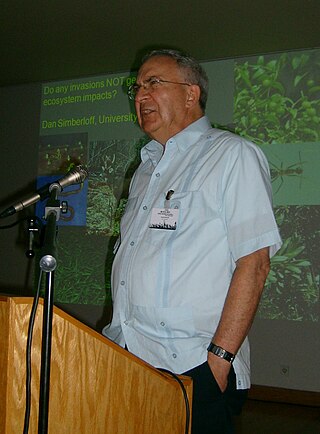
Daniel Simberloff is an American biologist and ecologist. He earned his Ph.D. from Harvard University in 1969. He is currently Gore Hunger Professor of Environmental Science at the University of Tennessee, editor-in-chief of the journal Biological Invasions, and a member of the National Academy of Sciences.

A riparian zone or riparian area is the interface between land and a river or stream. In some regions, the terms riparian woodland, riparian forest, riparian buffer zone,riparian corridor, and riparian strip are used to characterize a riparian zone. The word riparian is derived from Latin ripa, meaning "river bank".
Scottsdale Reserve is a 1,328-hectare (3,280-acre) nature reserve on the Murrumbidgee River in south-central New South Wales, Australia. It is 79 kilometres (49 mi) south of Canberra, and 4 kilometres (2.5 mi) north of Bredbo. It is owned and managed by Bush Heritage Australia (BHA), which purchased it in 2006. The purchase was supportive of projects aiming to connect existing fragmented remnant habitat such as K2C. Since the 1870s up until 2006, the land was used for agriculture – primarily sheep grazing with some minor cropping. A significant component of the Reserve has been cleared of native vegetation.

Tamarix ramosissima, commonly known as saltcedarsalt cedar, or tamarisk, is a deciduous arching shrub with reddish stems, feathery, pale green foliage, and characteristic small pink flowers.

Diorhabda carinulata is a species of leaf beetle known as the northern tamarisk beetle, which feeds on tamarisk trees from southern Russia and Iran to Mongolia and western China. This beetle is used in North America as a biological pest control agent against saltcedar or tamarisk, an invasive species in arid and semiarid ecosystems.
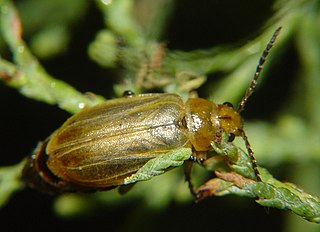
Diorhabda elongata is a species of leaf beetle known as the Mediterranean tamarisk beetle (MTB) which feeds on tamarisk trees from Portugal and Algeria east to southern Russia. The MTB is used in North America as a biological pest control agent against saltcedar or tamarisk, an invasive species in arid and semi-arid ecosystems.

Diorhabda carinata is a species of leaf beetle known as the larger tamarisk beetle which feeds on tamarisk trees from Ukraine, eastern Turkey and Syria east to northwest China, Kyrgyzstan and Pakistan, extending as far south as southern Iran. It is used in North America as a biological pest control agent against saltcedar or tamarisk, an invasive species in arid and semi-arid ecosystems.

Diorhabda sublineata is a leaf beetle known as the subtropical tamarisk beetle (STB). The species was first described by Hippolyte Lucas in 1849. It feeds on tamarisk trees from Portugal, Spain and France to Morocco, Senegal, Algeria, Tunisia, Egypt, Yemen, and Iraq. It is used in North America as a biological pest control agent against saltcedar or tamarisk, an invasive species in arid and semi-arid ecosystems.
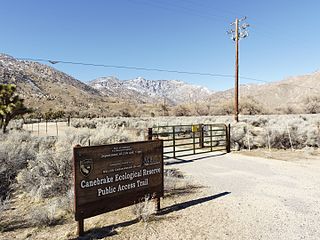
Canebrake Ecological Reserve is a 6,700-acre (27 km2) nature reserve in the South Fork Valley of Kern County, 20 miles (32 km) east of Lake Isabella, California. It is located in the Southern Sierra Nevada region.

Riparian-zone restoration is the ecological restoration of riparian-zonehabitats of streams, rivers, springs, lakes, floodplains, and other hydrologic ecologies. A riparian zone or riparian area is the interface between land and a river or stream. Riparian is also the proper nomenclature for one of the fifteen terrestrial biomes of the earth; the habitats of plant and animal communities along the margins and river banks are called riparian vegetation, characterized by aquatic plants and animals that favor them. Riparian zones are significant in ecology, environmental management, and civil engineering because of their role in soil conservation, their habitat biodiversity, and the influence they have on fauna and aquatic ecosystems, including grassland, woodland, wetland or sub-surface features such as water tables. In some regions the terms riparian woodland, riparian forest, riparian buffer zone, or riparian strip are used to characterize a riparian zone.
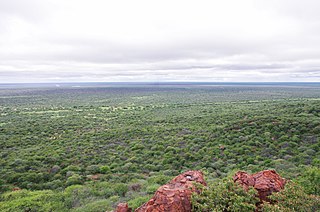
Woody plant encroachment is a natural phenomenon characterised by the increase in density of woody plants, bushes and shrubs, at the expense of the herbaceous layer, grasses and forbs. It predominantly occurs in grasslands, savannas and woodlands and can cause biome shifts from open grasslands and savannas to closed woodlands. The term bush encroachment refers to the expansion of native plants and not the spread of alien invasive species. It is thus defined by plant density, not species. Bush encroachment is often considered an ecological regime shift and can be a symptom of land degradation. The phenomenon is observed across different ecosystems and with different characteristics and intensities globally.
Arturo Gómez-Pompa is a tropical biologist, a scientific advisor for the Tropical Research Center of the Universidad Veracruzana (CITRO), and a professor emeritus of botany at the University of California, Riverside. He made various contributions to the field of tropical ecology through the creation of databases used in botanical research, and he contributed to the research on the domestication of tropical trees.
Nancy Huntly is an American ecologist based at Utah State University, where she is a Professor in the Department of Biology and director of the USU Ecology Center. Her research has been on biodiversity, herbivory, and long-term human ecology. She started her position at USU in 2011, after serving as a Program Officer in the Division of Environmental Biology at the National Science Foundation. Prior to that she was a faculty member in the Department of Biological Sciences at Idaho State University (Pocatello).
Erika S. Zavaleta is an American professor of ecology and evolutionary biology at the University of California, Santa Cruz. Zavaleta is recognized for her research focusing on topics including plant community ecology, conservation practices for terrestrial ecosystems, and impacts of community dynamics on ecosystem functions.
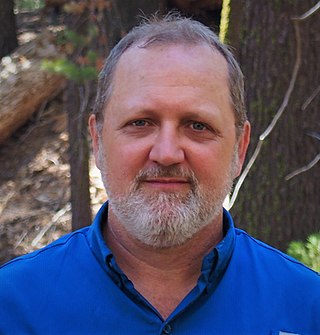
Bradley Cardinale is an American ecologist, conservation biologist, academic and researcher. He is Head of the Department of Ecosystem Science and Management and Penn State University.

Anna Traveset is a Spanish ecologist, particularly known for her work on ecological interactions between plants and animals, especially on islands.

Karin M. Kettenring is an American plant ecologist based in Logan, Utah. Her research focuses primarily on aspects of wetland plant ecology, including invasive plant ecology and management, native wetland seeds and seedlings, and wetland restoration. Kettenring worked in several labs and research stations across the United States before obtaining a faculty position at Utah State University as a professor of wetland ecology. Her most cited publication, “Lessons learned from invasive plant control experiments: a systematic review and meta-analysis,” looks at the literature discussing invasives species control experiments and how to ensure that research practices are most effective.
References
- 1 2 3 4 "Anna A Sher | Natural Sciences and Mathematics". science.du.edu. Retrieved 2021-06-06.
- 1 2 3 Tamarix: a case study of ecological change in the American West. Anna Sher, Martin F. Quigley. New York, NY: Oxford University Press. 2013. ISBN 978-0-19-989821-3. OCLC 843881808.
{{cite book}}: CS1 maint: others (link) - ↑ Sher, Anna Amelia (1998). Seedling ecology of competing riparian trees: native cottonwood (Populus deltoides subsp wislizenii) and invasive salt cedar (Tamarix ramosissima) (Thesis). Albuquerque, NM: University of New Mexico. OCLC 795601431.
- 1 2 "Meet Anna Sher Simon". TEDxMileHigh: Ideas Worth Spreading. 2016-06-25. Retrieved 2021-06-06.
- ↑ "faculty-directory/anna-sher". College of Natural Sciences and Mathematics> Faculty> Anna Sher. 2022. Retrieved May 30, 2022.
- ↑ Hurst, Alyssa (July 28, 2021). "DU Wins NSF ADVANCE Grant for Improving Equity in STEM" . Retrieved May 30, 2022.
- ↑ "Announcing the 2020 Faculty Awards". University of Denver. 2020-06-17. Retrieved 2021-06-23.
- ↑ "Annual Awards". University of Denver. Retrieved 2021-06-23.
- ↑ Sher, Anna A. (2022). An Introduction to Conservation Biology. Oxford University Press. ISBN 978-0-19-756437-0.
- ↑ Sher, Anna A.; Molles, Manuel (2021). Ecology Concepts and Applications. McGraw Hill Education. ISBN 978-1-265-28633-0.
- ↑ Sher, Anna A.; Quigley, Martin (2013). Tamarix: A Case Study of Ecological Change in the American West. Oxford University Press. ISBN 978-0-19-989820-6.
- ↑ "Anna Sher". 500 Queer Scientists. Retrieved 2021-06-06.
- ↑ "Denver clerk begins issuing same-sex marriage licenses". The Denver Post. 2014-07-10. Retrieved 2021-06-06.